Menus
- Comparison test: Ducati 1198 SP and KTM RC8 R
- Ducati 1198 SP
- KTM RC8 R
- MOTORCYCLE measurement
- Technology in detail
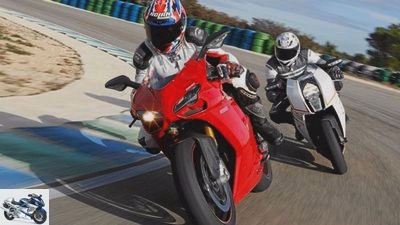
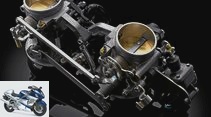
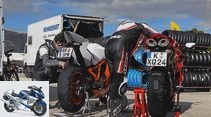
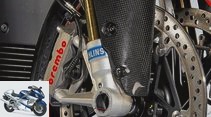
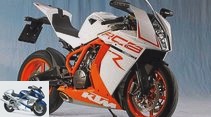
25th photos
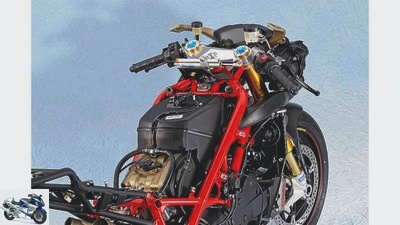
1/25
Classically functional tubular space frame.
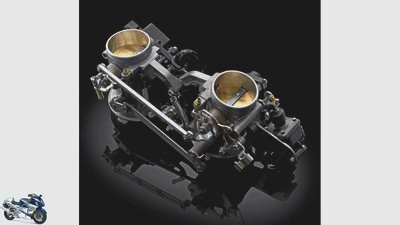
2/25
Throttle body.
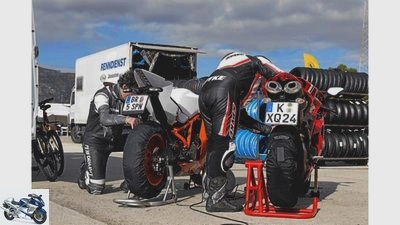
3/25
It has to be fun: sunny Spain, hot tires and two super twins.
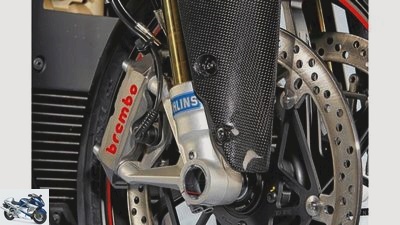
4/25
Traction control sensor, or DTC for short.
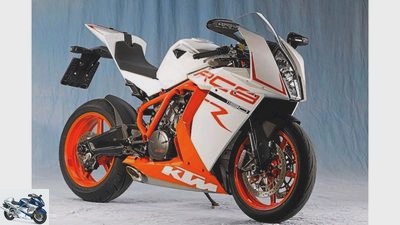
5/25
The even sharper R models from KTM can be recognized by the orange frame.
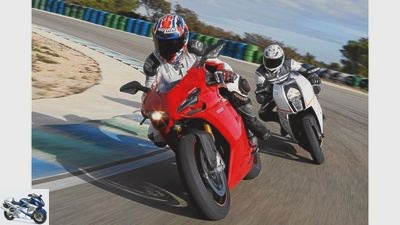
6/25
The two superbikes feel particularly at home on the racetrack.
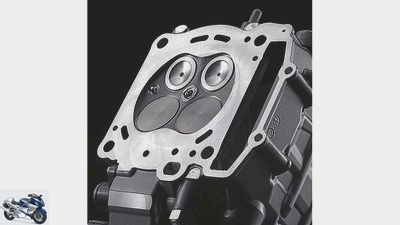
7/25
Cylinder head of the KTM RC8 R.
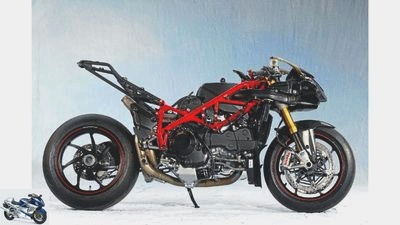
8/25
Rare sight: compactly tied, but very cumbersome and time-consuming attached plastic parts challenge the whole mechanic.

9/25
Four-valve cylinder head of the Ducati 1198 SP.
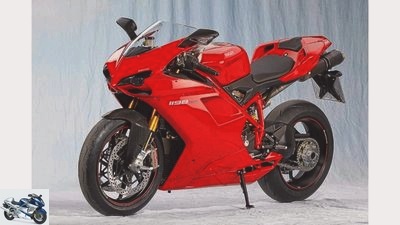
10/25
Classically beautiful and sporty elegant: The Ducati 1198 SP.

11/25
A winner cannot be chosen, both machines are bursting with performance and belong on the race track.
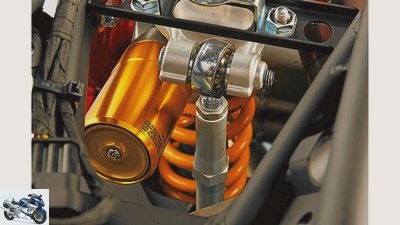
12/25
Deflection rocker with TTX suspension strut, high-quality ascubal ball heads, but a bit cumbersome height adjustment.
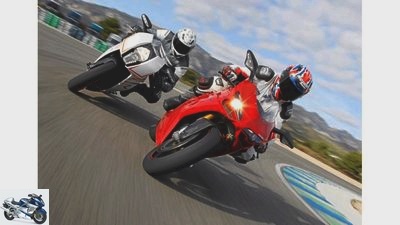
13/25
In terms of performance, the two racers are very close to each other.
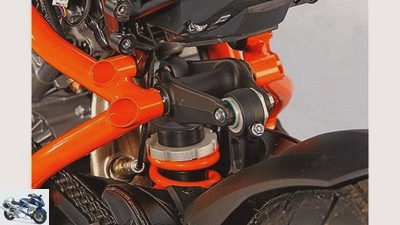
14/25
In no time at all: eccentric adjustment with clamping, push rods in the needle bearing, WP spring strut with soft adjustment.
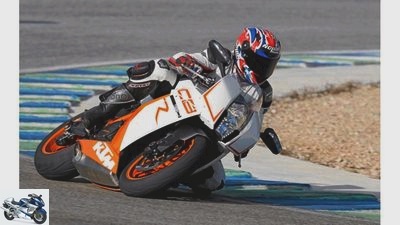
15/25
Makes running easy. Neutral chassis, great engine: KTM RC8R.
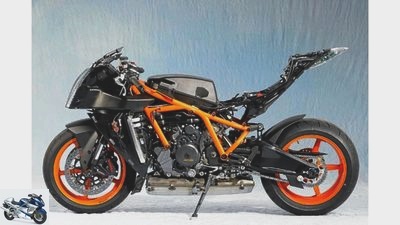
16/25
Well thought-out and screwdriver-friendly, the KTM RC8 R can be dismantled and reassembled in next to no time.
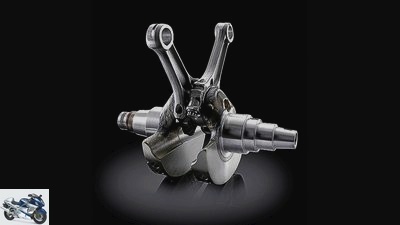
17/25
The new crankshaft and the heavier Lima rotor increase the rotating mass by 27 percent.
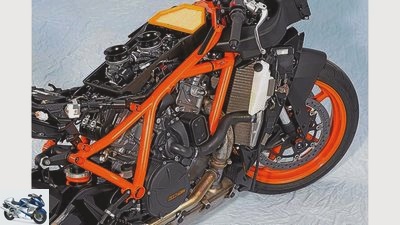
18/25
Stable and light bridge frame in the typical R orange.
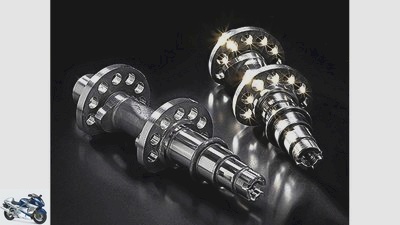
19/25
Two camshafts with desmodromic valve actuation do their job in the 1198 SP.
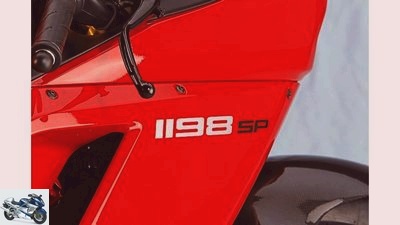
20/25
Ducati 1198 SP.
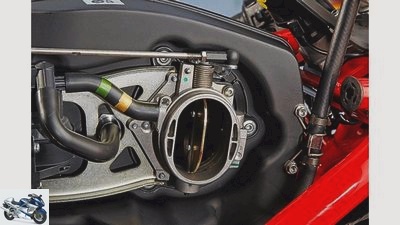
21/25
The Ducati uses throttle valves with a diameter of 66.5mm x 41mm.
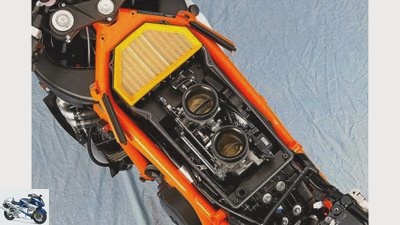
22/25
Two relatively small size 52 throttle bodies sit in the easily accessible airbox.
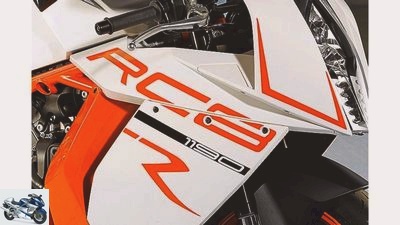
23/25
So that everyone can see what kind of racing machine they are dealing with here, KTM writes the model name in particularly large letters.
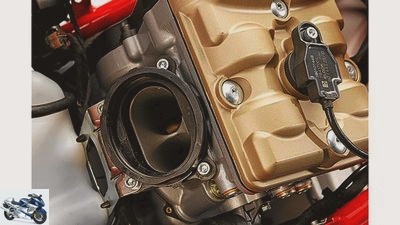
24/25
Oval suction nozzles ensure the best flow conditions.
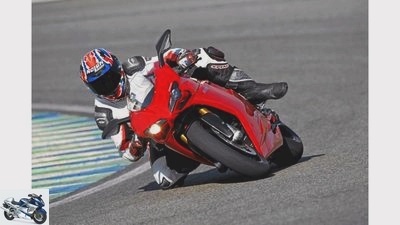
25/25
High cornering speed, good feedback, but exhausting: Ducati 1198 SP.
Supersport twins from Ducati and KTM (photo show and video)
Comparison test: Ducati 1198 SP and KTM RC8 R
In the battle for market and money, the 200 hp cars are in the front row. The recipe for success: power in sheer abundance, which can only be controlled with electronic aids. The alternative: wonderfully bassy twins with the finest technology and built-in driving pleasure guarantee – unfortunately threatened with extinction.
No segment is so rigidly focused on performance as that of the super sports car in the 1000 class. If you believed three or four years ago that the race at 180 hp would slow down by itself because more power could not be achieved, BMW slapped the S 1000 RR with around 200 hp in front of our feet. The concept: four cylinders in racing format, garnished with race electronics, and the best seller is ready. Hats off. But where is the fascination with 200 hp? Exactly, between 10,000 and 14,000 rpm, when the boxes are on fire, as if the real person was chasing after a Turbo-Gixxer. But in normal life? Monotonous four-cylinder noise, certainly highly cultivated, but also a bit uneventful.
There is another way. Press the start button of a Ducati 1198 SP or KTM RC8 R, wait until the pistons balance themselves above dead center and the flaming inferno causes the earth to shake. Real combustion engines, every work cycle an event, every gas blast proof that bare mechanics have a soul.
Buy complete article
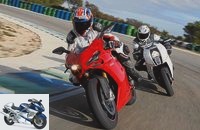
Supersport twins from Ducati and KTM (photo show and video)
Comparison test: Ducati 1198 SP and KTM RC8 R
Ducati flies to the sky. Torque in abundance and the feeling of a single stroke of the piston hammering you from one corner to the next. Even if the brutal thud of the Ducati twin stands in the way of the much-touted drivability, the 1198 SP demonstrates what is going on.
Up to gear three, the front wheel is lifted according to the pilot’s mood, the throttle control determines the force of the torque shaft, almost independently of the speed. The tendency towards the light front wheel is supported by the noticeably rear-heavy weight distribution.
Makes running easy. Neutral chassis, great engine: KTM RC8R.
Measured with the driver, only 47.5 percent of the total weight is on the front wheel, on the KTM, however, it is a balanced 50 percent. It’s good that the brute force of the Testastretta engine is kept in check by the traction control (DTC) and the 190/55 tire is kept on track. When accelerating out of long corners, there is noticeable movement in the rear, the rubber is kneaded vigorously, but at least at level 4 of 8 possible levels, it does not lose grip and the driver does not lose control. The whole thing is very calming and very healthy for people with a penchant for cockiness.
Squeezed out until the shift light flickers, the Italian twin shows itself from a completely different side. Silky smooth, almost vibration-free, the L-Twin sweeps through the speed range, the gear steps thread into their position in a flash thanks to the standard gearshift without any noticeable interruption of the tractive effort. During a leisurely stroll through town, on the other hand, you should do without the automatic gearshift, because then the gear change only takes place with a noticeably hard jolt and an ignition interruption that is far too long.
Unfortunately, Ducati has not yet combined the electronics package of the 1198 SP with racing ABS, so the driver has to rely on his manual abilities to apply the brakes accurately after the full-throttle orgy. Which would not be a problem with the exquisitely controllable Brembo system and the inconspicuous but efficient anti-hopping clutch, if the too soft tuning of the telescopic fork, which has been criticized for years, did not let the front suddenly sag to the stop.
High cornering speed, good feedback, but exhausting: Ducati 1198 SP.
For this, Ducati has synchronized the entire spring balance with the new, somewhat softer TTX shock absorber from Ohlins. The front-to-rear coordination now fits better, making the motorcycle more stable and predictable in alternating curves. But that doesn’t change the fact that the Ducati still needs powerful steering impulses for quick changes of direction. For this, the 1198 cuts razor-sharp ideal lines into the asphalt in long radii and with a courageous incline and conveys the feeling of an unstoppable rail vehicle. Supported by the front-heavy, but strenuous seating position, curve radii cannot be long, inclines cannot be sloping enough. Feedback, feeling for the limit area, everything is fine. But only if the driver has interlocked the slippery pegs of the footrests with a sharp crisscross pattern with the file before the big boom. As a reminder: The Ducatis have also been dragging this shortcoming around with them since the introduction of the Icon 916.
On the other hand, the 1198 SP also seamlessly picks up on the fantastic qualities of the 916 series and brings them up to date in 2011 in a neat manner. As the top model of the Superbike series with a proud price of 22,690 euros, the SP enters the legacy as a superbike Replica at. With 170 HP and a sensational 196 kg weight, the performance was a success. There’s no more two-cylinder experience, more V-Power, more Ducati.
It is undisputed that KTM also had the Ducati philosophy in mind when laying the foundation stone for the RC8 series. Because after the withdrawal of Honda’s VTR 1000 SP2 and the half-hearted Suzuki TL 1000 R experiment, two-cylinder models were more than sparse. And despite all the similarity of the technical key data with the Ducati, the RC8 is a completely different, completely unique type. Edgy, provocative, doesn’t care about any aerodynamic round cut.
As if the RC8 had been designed for getting bread rolls, you sit casually and relaxed on the seat cushion, which is still too hard. The nice thing about it: The RC8 R has an endless number of adjustment options in terms of ergonomics and chassis setup. If you can’t find a solution here, you should orientate yourself in the chopper scene.
It has to be fun: sunny Spain, hot tires and two super twins.
Cultivated bit by bit over the years, the new RC8 motor has developed tremendously in terms of smoothness and load changes. With one kilogram more flywheel mass, that is exactly 27 percent of the total crank mass, and the double firing of the combustion chambers by means of a second, asymmetrically placed ten millimeter spark plug, the twin hums evenly and homogeneously, pulls out of idle gas without holes or jerks Come on. As part of the facelift, the gearshift became smoother and the gears more precise and secure. That’s the way it should be.
The chassis was trimmed even more towards comfort with a soft 85 spring on the WP shock absorber in order to make the RC8 R fit primarily for road use. At 205 kilograms she has put on a few creases of fat, but these do not come into play in the fast-paced chase around the winding course of Calafat. Using the practical setting options, the geometry was shifted towards handiness. With this, the initially slight understeer could be converted into an almost force-neutral steering behavior with good accuracy.
Once adjusted, there was nothing to click even when using different tires. Tame and unproblematic, the RC8 R proves to be a very fun companion, who is not only on a par with the Ducati in terms of engine torque and power delivery, but also slightly superior. It is true that the 75-degree V2 doesn’t hit your newton meters brutally like the Ducati, but you can rely on the Twin to maneuver along the borderline in a very controlled manner even without traction control and when the Ducati sprints from curve to curve not a hand’s breadth of air. On the contrary. The 2D data recordings show that the RC8 R is always a touch faster at the end of the straight than the aerodynamically more sophisticated Ducati and thus compensates for the small advantages of the curvy and more precise 1198. A simple increase in idle gas when downshifting reduces the braking torque of the two-cylinder so effectively that you don’t have to keep a jumping rear wheel in check even when knocking down the gears.
A winner cannot be chosen, both machines are bursting with performance and belong on the race track.
Subjectively more manageable than the Ducati, the KTM rushes through the chicanes of Calafat and makes the lighter, more agile impression. Which primarily has to do with the casual seating position. If you ask about the data recording, the Ducati whips through the harassment a bit faster, albeit with subjectively more physical effort. Advantage of KTM: less physical stress for the driver with slightly better lap times of less than 3/10 seconds. Advantage Ducati: Reliable traction control and an automatic gearshift make you ready to race – which is what the KTM actually wrote on their flags. Well, KTM has already provided the attachment points for the ABS and traction control sensors. And it is also clear that the RC8 R, which costs 16295, can pack one more thing in terms of racing technology. After all, the basic equipment is the "R." but shrunk a lot.
The light forged wheels were replaced by cast wheels, and carbon fiber fenders were replaced by simple plastic parts. But that doesn’t change the fact that the 2011 KTM is the best RC8 R of all time.
One goal, two ways. Ducati has not lost sight of the radical philosophy of the 916 and follows the consistent line with the 1198 SP: radical, fast, but exhausting. Anything else would be treason. KTM is allowing itself to redefine the topic of super sports twin. Shrill design, a casual seating position and a powerful engine that is superior to the Ducati Twin not only in terms of maximum performance. Ask your Ducati or KTM dealer about risks and side effects.
Here is the video of the test:
Ducati 1198 SP
Classically beautiful and sporty elegant: The Ducati 1198 SP.
engine:
Water-cooled two-cylinder four-stroke 90 degree V-engine, two overhead, toothed belt-driven camshafts, four valves per cylinder, desmodromic actuation, wet sump lubrication, injection, Ø 64 mm, regulated catalytic converter, 520 W alternator, 12 V / 12 Ah battery, Hydraulically operated multi-plate dry clutch, six-speed gearbox, O-ring chain, secondary ratio 38:15.
Bore x stroke 106.0 x 67.9 mm
Displacement 1198 cm3
Compression ratio 12.7: 1
rated capacity 120.0 kW (163 hp) at 9750 rpm
Max. Torque 131 Nm at 8000 rpm
landing gear:
Steel tubular frame, load-bearing motor, upside-down fork, Ø 43 mm, adjustable spring base, rebound and compression damping, single-sided swing arm made of aluminum, central spring strut with lever system, adjustable spring base, rebound and compression damping, double disc brake at the front, Ø 330 mm, four-piston Fixed calipers, rear disc brake, Ø 245 mm, two-piston fixed caliper, traction control.
Forged aluminum wheels 3.50 x 17; 6.00 x 17
Tires 120/70 ZR 17; 190/55 ZR 17
Pirelli Supercorsa SP tires tested
Mass and weight:
Wheelbase 1430 mm, steering head angle 65.5 degrees, caster 104 mm, spring travel f / r 120/127 mm, seat height * 810 mm, weight with a full tank * 196 kg, weight distribution 49/51%, with driver 47.3 / 52.7% , Payload * 194 kg, tank capacity 18.0 liters.
guarantee two years
Mobility guarantee a year
Service intervals 12,000 km
Colours Red Black
price 22,690 euros
Additional costs around 255 euros
* MOTORCYCLE measurements
KTM RC8 R
The even sharper R models from KTM can be recognized by the orange frame.
engine:
Water-cooled two-cylinder four-stroke 75-degree V-engine, crankshaft lying transversely, two overhead, chain-driven camshafts each, four valves per cylinder, bucket tappets, dry sump lubrication, injection, Ø 52 mm, regulated catalytic converter, 450 W alternator, 12 V battery / 11 Ah, hydraulically operated multi-disc oil bath clutch, six-speed gearbox, O-ring chain, secondary ratio 37:17.
Bore x stroke 105.0 x 69.0 mm
Displacement 1195 cc
Compression ratio 13.5: 1
rated capacity 129.0 kW (175 hp) at 10250 rpm
Max. Torque 127 Nm at 8000 rpm
landing gear:
Steel tubular frame, load-bearing motor, upside-down fork, Ø 43 mm, steering damper, adjustable spring base, rebound and compression damping, two-arm swing arm made of aluminum, central spring strut with lever system, adjustable spring base, rebound and compression damping, double disc brake at the front, Ø 320 mm, Four-piston fixed calipers, rear disc brake, Ø 220 mm, two-piston fixed calipers.
Forged aluminum wheels 3.50 x 17; 6.00 x 17
Tires 120/70 ZR 17; 190/55 ZR 17
Dunlop SportSmart tires tested
Mass and weight:
Wheelbase 1425 mm, steering head angle 66.7 degrees, caster 97 mm, spring travel f / r 120/120 mm, seat height * 840 mm, weight with a full tank * 205 kg, weight distribution 53/47%, with driver 50/50%, payload * 175 kg, tank capacity / reserve 16.5 / 3.5 liters.
guarantee two years
Mobility guarantee a year
Service intervals 7500 km
Colours Black-and-white
price 16,295 euros
Additional costs around 200 euros
* MOTORCYCLE measurements
MOTORCYCLE measurement
Drawing: archive
The performance diagram of the two super athletes.
With a torque curve like a picture book and an unbelievable 173 hp, the KTM engine also proves its excellent performance and perfect drivability on the test bench. In 95 RON mode, the test bench showed a power loss of four hp at around 8000 rpm, and the curves are congruent over long distances. The Ducati engine feels just as aggressive in real life as the humped torque curve suggests. What makes the brisk hunt a sweaty pleasure.
Top speed (Manufacturer information):
| Manufacturer | Km / h | Ducati | 288 |
| KTM | 287 |
acceleration:
| Manufacturer | 0-100 km / h | 0-140 km / h | 0-200 km / h | Ducati | 3.3 | 4.9 | 8.4 |
| KTM | 3.2 | 4.7 | 8.2 |
Draft:
| Manufacturer |
60-100 km / h |
100-140 km / h |
140-180 km / h |
Ducati |
3.6 | 3.3 | 4.1 |
| KTM |
3.1 | 3.2 | 3.4 |
Technology in detail
Four-valve cylinder head of the Ducati 1198 SP.
With their superbike engines, Ducati and KTM pull out all the stops of modern engine design in order to be able to keep up with the performance explosion of the four-cylinder group.
As a consequence, Ducati implements the desmodromic valve control. No other manufacturer dares to use the elaborate lever design with closer and opener cams, which, through the forced actuation of the valves, allow control times that conventional systems cannot. Who would have thought it possible that this L-engine concept has existed since its introduction by Massimo Bordi in the racing Ducati F1 from 1986 to the present day, and is justified with 14 world championships?
The cylinder head of the KTM RC8 R..
The KTM engineers have brought their RC8 R drive in the 2011 version with 27% more flywheel mass exactly to the level of the 990 enduro engine. The goal: less vibrations, better concentricity and fewer load changes. As a further modification, a second, only ten millimeter small spark plug with a low heat value of seven was used in order to achieve additional clean combustion in the critical edge zones at lower speeds or during the warm-up phase.
The new crankshaft and the heavier Lima rotor increase the rotating mass by 27 percent.
The centrally placed twelve-millimeter candle with a heat value of nine is ignited at high speeds in front of the small candle and thus takes on a higher thermal load. An improved torque curve and lower consumption are the pleasant consequences of this development stage. The designers found around one horsepower more power in the venting of the crankcase, which is subjected to negative pressure, as in Formula 1 engines, which reduces pumping losses and oil spillage to a minimum. New at KTM: Ignition / injection management can now be adjusted to 95 or 98 RON fuel via the display in the cockpit. With the high compression ratio of 13.5: 1, it is certainly a smart idea.
MOTORRAD editor Werner "Mini" cook.
Rappelkiste or robust drive
"A motorcycle cannot be two-cylinder enough", says MOTORRAD editor Werner "Mini" cook.
Granted, large two-cylinder engines sometimes behave a bit rude. City trips and stop-and-go are not what big-capacity, high-performance twins do. Because the mechanical background noise suggests that the motor does not have all the screws in the housing and that technically adept passers-by suspect a bearing damage. No question about it, in such situations four-cylinder whispers in a sophisticated and mechanically pure manner the high song of perfection. But I don’t ride a motorcycle to have fun in the tough city traffic, but to plow over godforsaken gravel roads with an Africa Twin on Saturday mornings or to shoot over the Swabian Alb with an RC8. And on such occasions, there is nothing better than catapulting yourself into orbit with the full blow of a two-cylinder. Without revving up, without waiting for the performance kick. Just like that, storm from curve to curve with the sheer power of the wrist.
Speaking of which: the MOTORRAD editors, too, mainly rely on two-cylinder products in their private lives. Editor-in-chief Michael Pfeiffer has secured a Buell before the gate closes, innovations specialist Ralf Schneider goes for a walk with a Ducati 916 and KTM Adventure 950, and fleet manager Rainer Froberg gondolas to work in his Kawasaki W 650. And please don’t forget: The currently best-selling motorcycle has a two-cylinder across the wheels. In this sense, it remains the same: Twins only.
Reader call:
Here is your feedback on our readers’ call on your opinion about Twins: Reader’s opinion
Related articles
-
Jahn 29 photos Ducati 1/29 Ducati 1198 S.. Ducati 2/29 Ducati 1198 S.. Ducati 3/29 Ducati 1198 S.. Ducati 4/29 Ducati 1198 S.. Ducati 5/29 Ducati 1198…
-
Comparison test of the sports tourers from BMW and Honda
fact 12th photos fact 1/12 Top brakes: radially screwed six-piston stoppers, ABS and integral actuation. fact 2/12 Builds compact and very narrow: the…
-
Jahn comparison test Supermoto The five percent hurdle More gas, more fun. MOTORRAD shows you four attractive ways to use your full throttle in …
-
Jahn 19th photos Jahn 1/19 11,200 euros have to be raised for this fascinating motorcycle. But you get a two-year guarantee, as well as an equally long…
-
Comparison test of the 1000 super sports car, part 1
Jahn Comparison test of the 1000 super sports car, part 1 The full program Lean, strong, ready for attack, the Suzuki GSX-R 1000 completes the field of…
-
Moto Guzzi V7 Special and Moto Guzzi V7 II Special in comparison test
fact 38 pictures fact 1/38 Moto Guzzi V7 Special and Moto Guzzi V7 II Special in a comparison test. fact 2/38 … the Moto Guzzi V7 II Special scores with …
-
Comparison test: large naked bikes
fact comparison test: Large naked bikes, BMW K 1300 R, Honda CB 1300 S, Suzuki B-King, Yamaha XJR 1300 Large naked bikes in comparison Contents of a …
-
Comparison test: Ducati 1198 S against Ducati Multistrada 1200 S
Jahn Comparison test: Ducati 1198 S against Ducati Multistrada 1200 S Ducati 1198 S versus Ducati Multistrada 1200 S Content of One brand, one engine,…
-
Track test Ducati 999 R-Suzuki GSX-R 1000
Gargolov Track test Ducati 999 R / Suzuki GSX-R 1000 There is more to it … …than just whether the brand new Suzuki GSX-R 1000 or the sinfully…
-
Comparison test of two-cylinder: Ducati 750 Sport, Laverda 750 SF and Moto Guzzi 750 S
29 photos 1/29 Twin and away: the Ducati 750 Sport, Laverda 750 SF and Moto Guzzi 750 S in a comparison test. 2/29…